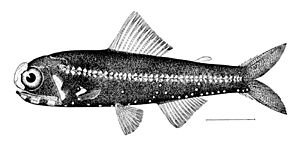Headlight fish facts for kids
Quick facts for kids Headlight fish |
|
|---|---|
 |
|
| An illustration of the headlight fish, in the 1896 edition of Oceanic Ichthyology by Goode and Bean | |
| Conservation status | |
| Scientific classification | |
| Synonyms | |
|
The headlight fish (Diaphus effulgens) is a type of lanternfish. It belongs to the Myctophidae family of fish. People sometimes call it the headlight lanternfish. It is also just called a lanternfish, but many other fish share that name.
Contents
What Makes the Headlight Fish Special?
The headlight fish is easy to spot! It has a big, glowing patch on the front of its head. This bright patch is why it's called the "headlight" fish. It helps tell it apart from other deep-sea fish. This fish can grow up to 15 centimeters (about 6 inches) long.
How Does the Headlight Fish Glow?
The glowing patch on its head is a special feature. It uses something called Bioluminescence. This means the fish can make its own light! It's like a built-in flashlight in the dark ocean.
Who Discovered the Headlight Fish?
Two American scientists first described the headlight fish. Their names were George Brown Goode and Tarleton Hoffman Bean. They found and named this fish in 1896.
What Does Its Name Mean?
The scientific name for the headlight fish is Diaphus effulgens.
- Diaphus comes from Greek words. "Dia" means "through" and "Physa" means "bellows."
- Effulgens is a Latin word. It means "glittering" or "flashing."
So, its name basically means "flashing through," which makes sense for a glowing fish!
Where Do Headlight Fish Live?
Headlight fish live in many parts of the world's oceans. You can find them in the Atlantic Ocean, the Pacific Ocean, and the Indian Ocean.
Ocean Habitats of the Headlight Fish
In the eastern Atlantic, they live from the English Channel down to the Antarctic. In the western Atlantic, they are found from the United States coast down to Brazil. In the Indian Ocean, they are usually found between 5°S and 38°S latitude. In the Pacific, they live near Southeast Asia, Australia, and New Zealand.
How Deep Do They Swim?
These fish are deep-sea creatures. During the day, they swim very deep. They can be found from 501 to 700 meters (about 1,644 to 2,297 feet) below the surface. But at night, they swim closer to the surface. At night, you might find them from 40 to 175 meters (about 131 to 574 feet) deep. This daily up-and-down movement is called vertical migration.


